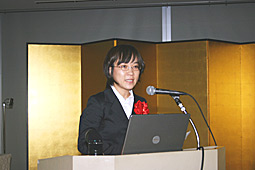 The 7th Iue Asia Pacific Research Prize Winner: Sayuri Inoue
The 7th Iue Asia Pacific Research Prize Winner: Sayuri Inoue
Title of Dissertation: "The Formation of Genre in Burmese Classical Song-with Special Reference to U Sa's Creation between the 18th and the 19th Centuries-"

- Winner: Sayuri Inoue
-
- 【Career】
Graduated from Indochinese Studies, Faculty of Foreign Studies, Tokyo University of Foreign Studies in 1994. Completed her master in the Graduate School of Area and Culture Studies Asian Studies 2 of the same university in March 1997. After starting her doctoral course in April 1998, she left for Myanmar to study at Faculty of Music, University of Culture from 1999 to 2001 as a scholarship student granted by the Matsushita International Foundation. Completed the doctoral course in the Graduate School of Area and Culture Studies, Tokyo University of Foreign Studies in March 2004 and obtained a PhD of Arts in June 2007. After holding position as Research Fellow of Japan Society for the Promotion of Science (PD), she has held her current position as a part-time lecturer of Tokyo University of Foreign Studies since November 2005.
- 【Career】
This dissertation discusses Burmese classical songs which are now canonized, and elucidates the dynamism by which the internal genre was generated from a historical point of view. Specifically, I will focus on the genre patpyo, a form of classical music which appeared in the 18th century, in a discussion from four perspectives: editing song anthologies; constitution of musical scale; creating technique; and author Myawadi Mingyi U Sa’s view (1766-1853). Patpyo is considered to be the most vital of classical music genres and has the largest number of songs.
The dissertation is composed of 7 Chapters.
In Chapter 1, I indicate the paper’s position and significance relative to existing studies.
In Chapter 2, through an analysis of palm leaf manuscripts (1788 – 1917) compiled as song anthologies, I disprove the generally accepted idea that the notion of genre was present from the time the songs were composed. I point out that the genre classification became clearly recognized only after the 1870s when a large number of song anthologies began to be compiled. I verify the specific process through the steps below.
In Chapter 3, I show the five marks that assumed as constituting a certain genre: mode, rhythmic patterns, tunes frequently used in a certain genre, and preludes and postludes which are fixed according to a certain genre. I show that while the genre and the marks are linked, there are songs which at times deviate from the marks. That is, we see that there are no boundaries between genres but there are songs which span two genres. I call these songs “double-barreled genre.”
In Chapter 4, I point out the characteristic that in the case of classical songs, songwriting consists of combining existing materials. The ethnomusicologist Judith Becker noticed a commonality in the melody patterns of kyo song genre and called this the overlap of patterns. However, I assume this analysis as being synchronic and asserts the need to take a diachronic view of these songs through materials from the same period.
In Chapter 5, I analyze classical songs to point out that the songs of U Sa in the genre of patpyo were almost all originally composed.
In Chapter 6, I suggest the process by which a given series of songs eventually come to be recognized as a genre. That is, U Sa, who is recognized by posterity to have composed many patpyo songs, did not write the name of the genre patpyo in the song anthology he edited himself in 1849, but called the songs “thanzan (novelty sound).” An analysis of anthologies compiled in later years (“Song titles” (1870), “The earth of mahagita” (1881), and “The prominence songs” (1917)) reveals a process in which songs which imitate the “novelty sound” began appearing, gradually accumulating with similar songs, and coming to be recognized as a genre.
Thus I arrived at the following conclusion in regard to the dynamics of genre formation. The genre which came to be called patpyo in later generations was created through the author U Sa creating a new type of song, which was then followed by other authors, and only after an accumulation of songs occurred did the songs come to be recognized as a genre. There were also many songs which were classified under different genres in different manuscripts, which suggested these were likely to be “double-barreled genre” songs, positioned at the boundaries of the genres, and whose genre became fixed through the process of editing the songs. That is, the genre of patpyo was created through the process of “double-barreled genre” songs becoming pushed into the background through editing, with the songs being placed in one field.
The genres in Burmese classical songs are the movement of giving a name to the flow of music composition and can be said to be a “process” which holds history inside itself. I also conclude that genres are not definable by certain marks or by the songs, but can be thought to be a ceaseless orientation toward classification accompanied by interpretation.






